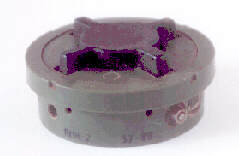Landmines and Cluster Bombs: a worldwide plague
It is hoped that this page will help to raise awareness of this problem.
Some of this information is a little dated: the page was first written (in some anger)
after a visit to Cambodia in 1996.
The comments about landmines apply equally to
cluster bombs, which technically skirt
the prohibitions against landmines. But these weapons are so frequently defective, leaving
a live bomb waiting for a child, that their effects are similar.
For example, the American CBU-58 is designed for a reliability of 95%. With 650 submunitions
per bomb, that means 38 possible duds, and 38 legless children.
These effects are so similar to landmines, that I suspect they
are intentionally used in that way. Do some countries (you know who you are) intentionally fit
"defective" fuzes, so as to act as deniable landmines? I wonder...
These |
cause |
This |
 Typical anti-personnel mine
Typical anti-personnel mine |
 Typical cluster bomblet
Typical cluster bomblet |
|
 Legless Child, Cambodia.
Legless Child, Cambodia.
Photo: Landmines Blow! |
Historical note: Presently, the term "landmine" is used for any explosive trap
placed on land, whether intended for humans or vehicles.
During World War II, such devices were simply termed "mines", with "landmine" reserved
for German naval mines dropped on land by parachute, as an improvised
bomb. This page uses "landmine" in its modern sense, with particular reference to
anti-personnel (rather than anti-vehicle) mines.
Landmine facts:
- Anti-personnel mines are designed to maim, not to kill. A crippled victim screaming
demoralises other people, and needs ongoing medical aid, so depleting an enemy's
resources. A dead victim is simply buried.
- Mines are a problem everywhere a war has been fought since the 1960's (and in some
World War II theatres also). That includes much of Asia, Africa, Central America and
parts of Europe.
- Estimated mine totals: 110 million mines in 64 countries.
- Small mines cost about $1 to make, and $100 to locate and remove (assuming they are
found & removed safely).
- Modern mines contain little or no metal: to make detection as difficult as possible.
- At the present rate, it will take 1000 years to rid the world of mines, but
- For every mine located & cleared, 10 more are laid.
- In Cambodia, 1 in 236
people is an amputee. Mines are the reason.
- Mines are 10 times more likely to injure a civilian than a combatant. - UN estimate.
- Mines have destroyed the entire economy of countries such as Afghanistan. Farmers
are unable to work their fields, which they dare not enter. The land is as effectively
denied to agriculture as if it had been subjected to massive chemical pollution.
In some cases, desperate farmers have attempted to dig out the mines themselves, using
long-handled hoes. Terrorist groups (I refuse to dignify such people with the name
"insurgent", still less "freedom fighter") have taken to placing mines upside down,
specifically so that a hoe applied from beneath will trigger the fuze.
Mine clearance
Mine-clearance operations proceed entirely differently in a military or humanitarian
situation.
Military mine-clearance is commonly directed toward clearing a path for
one's troops to advance. Speed is of the essence, and a limited clearance rate (maybe 80%)
is acceptable.
The advancing troops will take casualties due to enemy fire, so limited additional
casualties due to uncleared mines are acceptable.
Humanitarian demining may take as long as required, but 100% clearance
is mandatory. One mine missed is one legless child.
Humanitarian mine clearance proceeds in 3 steps:
- Detection
The traditional electronic "mine detector" is of limited value against modern non-metallic
designs. A further problem is the huge amount of other metallic debris (bomb splinters,
fired bullets, etc.) which litter a modern battlefield. Some estimates give one real
detector "hit" on a live mine to 1000 false alarms.
Other methods are being tried,
including thermal imaging and subsurface radar. But the success rate is still low. In
most cases, someone has to walk into the suspected minefield, operating the detector.
Casualty rates are high.
- Identification
Once a suspected mine is found, it must be exposed for examination. The work proceeds
like an archaeological "dig", with the surrounding earth slowly removed to expose the
mine. This nerve-wracking job can only be performed by hand.
- Disposal
Once identified, a mine may be destroyed in situ, by firing a small explosive charge near
the mine, so detonating its own explosive filling. Alternatively, the mines may be
removed and collected, for subsequent disposal in bulk.
It is essential that the mines
are actually destroyed, as otherwise there is a high risk of theft for sale to either
regular armies or insurgents. In either case, the same mine will later have to be cleared
again.
Links
 Typical anti-personnel mine
Typical anti-personnel mine Typical cluster bomblet
Typical cluster bomblet Legless Child, Cambodia.
Legless Child, Cambodia. Typical anti-personnel mine
Typical anti-personnel mine Typical cluster bomblet
Typical cluster bomblet Legless Child, Cambodia.
Legless Child, Cambodia. Canadian Department
of Foreign Affairs and International Trade
Canadian Department
of Foreign Affairs and International Trade Back to Home Page
Back to Home Page